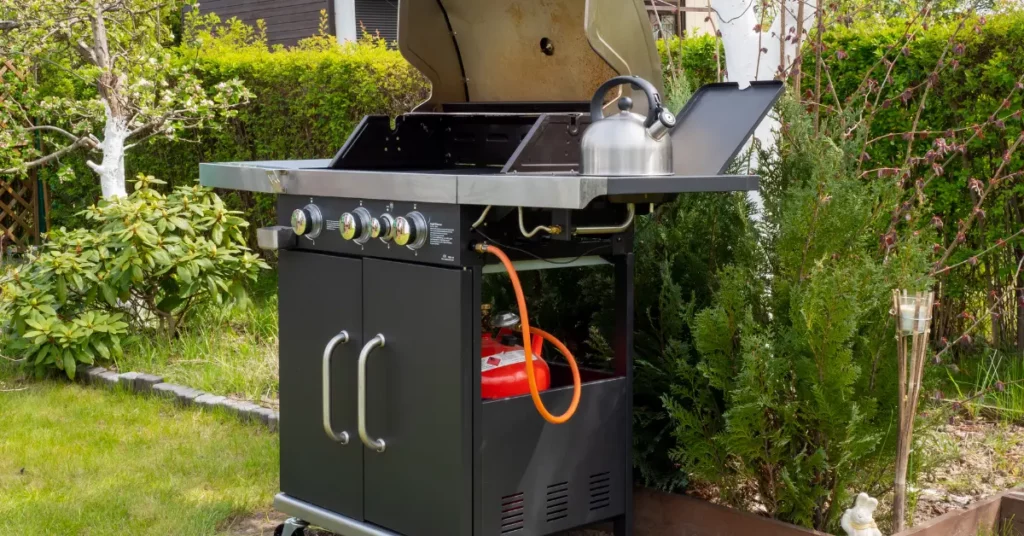This post may contain affiliate links. If you use these links to buy something we may earn a small commission. Thanks.
If you’re tired of constantly refilling propane tanks or want a more efficient and reliable way to fuel your BBQ, connecting your grill to a natural gas line could be the perfect solution. Natural gas offers an uninterrupted fuel source, can be more cost-effective in the long run, and saves you from mid-cookout tank runouts. However, this upgrade requires careful planning and strict safety measures. In this guide, we’ll walk you through everything you need to know about how to connect a natural gas line to a BBQ safely, correctly, and confidently.
Why Choose a Natural Gas BBQ?
Using a natural gas line instead of propane comes with several clear advantages:
- No more tank refills: Enjoy uninterrupted grilling without worrying about running out of fuel mid-session.
- Lower cost over time: Natural gas tends to be cheaper per BTU compared to propane.
- Eco-friendlier option: Natural gas burns cleaner than propane.
- Increased convenience: With a permanent gas line, your grill is always ready to go.
However, this convenience comes with a crucial need for proper installation. Incorrect setup can lead to gas leaks, fire hazards, or damage to your grill. Always prioritize safety when working with natural gas.

Tools and Materials You’ll Need
Before beginning the installation, gather all the necessary tools and components. Having everything on hand will help ensure a smooth and safe process.
Essential tools and supplies:
- Adjustable wrench or pipe wrench
- Pipe thread sealant or Teflon tape (specifically rated for gas)
- Flexible natural gas hose with quick-connect fitting
- Leak detection solution (or a homemade mix of dish soap and water)
- Shut-off valve (if not already installed)
- Screwdriver or pliers (depending on grill and fittings)
- Optional: drill and mounting hardware for hose supports
Check Local Building Codes and Permit Requirements
Before you dive into the project, it’s essential to consult your local building or utility codes. In some areas, connecting a natural gas line requires:
- A permit from the city or county
- Inspection by a certified professional
- Installation by a licensed plumber or gas technician
Failing to comply can result in fines, safety hazards, or even legal liability. When in doubt, contact your local gas company or city inspector’s office for guidance. It’s better to spend a bit more upfront for safety than to risk a dangerous situation later.
Prepare Your BBQ Grill for Natural Gas
Not all BBQ grills are compatible with natural gas out of the box. If your grill is designed for propane, you’ll need a conversion kit to switch fuel sources.
Check compatibility:
- Look in the user manual or the label near the fuel connection point.
- Some grills are “dual fuel” and can handle both propane and natural gas with minor changes.
Using a conversion kit:
- The kit typically includes new burner orifices, a regulator, and hoses.
- Follow the manufacturer’s instructions carefully.
- If you’re unsure, consult the grill’s manufacturer or a certified technician.
Skipping this step or installing the wrong components can damage your grill or create unsafe pressure differences.
Shut Off the Main Gas Supply
This is perhaps the most important step of the entire process. Before touching any part of your gas system:
- Locate the main gas shut-off valve (usually near your gas meter).
- Turn the valve to the “OFF” position.
- Wait a few minutes to ensure all residual pressure is released.
For added security, ventilate the area and avoid using any electrical tools or open flames near the work site.
Install or Locate the Outdoor Gas Connection
If you already have an outdoor gas line stub-out with a shut-off valve, you can move directly to the connection step. If not, this section will guide you through the basics of preparing your hookup point.
Existing line:
- Inspect the condition of the valve and threading.
- Ensure the valve is accessible and turns freely.
Installing a new outdoor stub-out:
- This should be done by a licensed gas technician.
- The technician will tee off your main gas line and run a branch to your patio or deck.
- Install a weather-rated shut-off valve with a cap or quick-connect socket.
Even if you’re confident in DIY work, running or modifying gas lines is not recommended unless you have gas plumbing experience.
Connect the Natural Gas Hose to the BBQ
Once the outdoor gas supply point is ready and the grill is converted (if necessary), you can connect the hose.
- Apply gas-rated thread sealant (or yellow Teflon tape) to the male end of your grill’s gas inlet.
- Attach the quick-connect adapter to the grill.
- Plug the natural gas hose into the grill’s quick-connect fitting.
- Connect the other end of the hose to the outdoor gas line quick-connect socket.
These quick-connect systems usually have a sliding sleeve that locks the hose securely in place.
Tip: Avoid using excessive force on fittings. Hand-tighten first, then use a wrench to snug the connection securely.
Turn On the Gas and Check for Leaks
Now comes the moment of truth but don’t fire up the grill just yet!
- Slowly turn on the main gas supply.
- Open the outdoor shut-off valve.
- Mix a solution of dish soap and water in a spray bottle.
- Spray the solution generously on all gas fittings and connections.
- Look for bubbles. If you see any forming, that’s a leak.
If a leak is detected:
- Turn off the gas immediately.
- Re-tighten the fittings or reapply sealant as needed.
- Recheck with the soap solution.
Never ignore a leak, no matter how small it appears.
Test the Grill for Proper Operation
Once you’re confident that there are no leaks, it’s time to test the grill.
- Turn on the grill burners one at a time.
- Use the built-in igniter or a long lighter to ignite.
- Observe the flame color and strength – it should be steady and mostly blue.
- Test all burners to ensure even flame distribution.
If the flames are yellow or weak:
- Double-check that the grill was properly converted.
- Ensure all orifices and valves are clean and unclogged.
- Call a technician if the problem persists.
Maintenance and Safety Tips
Congratulations your natural gas BBQ is now connected! To keep everything safe and in top condition, follow these ongoing tips:
- Inspect the hose regularly for cracks or wear.
- Keep the connection area clean and dry.
- Turn off the shut-off valve when the grill is not in use.
- Avoid dragging or kinking the hose during grill movement.
- Test for leaks once or twice a season using the soap solution method.
- Schedule a professional inspection annually if you use your grill frequently.
Never use makeshift materials or alter your gas setup without proper certification. Gas is extremely volatile and must always be handled with caution.
Conclusion
Connecting your BBQ to a natural gas line can elevate your outdoor cooking experience by providing continuous fuel, reducing long-term costs, and eliminating the hassle of propane tanks. While the project is manageable for some DIYers, always follow safety protocols, use proper materials, and respect local regulations. When in doubt, call in a professional to handle the installation.
Whether you’re a weekend griller or a full-time backyard chef, a natural gas BBQ setup means you’re always ready to fire it up. Enjoy the convenience, but never compromise on safety your perfect grill experience depends on it.
